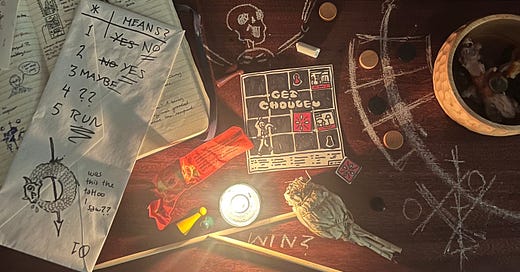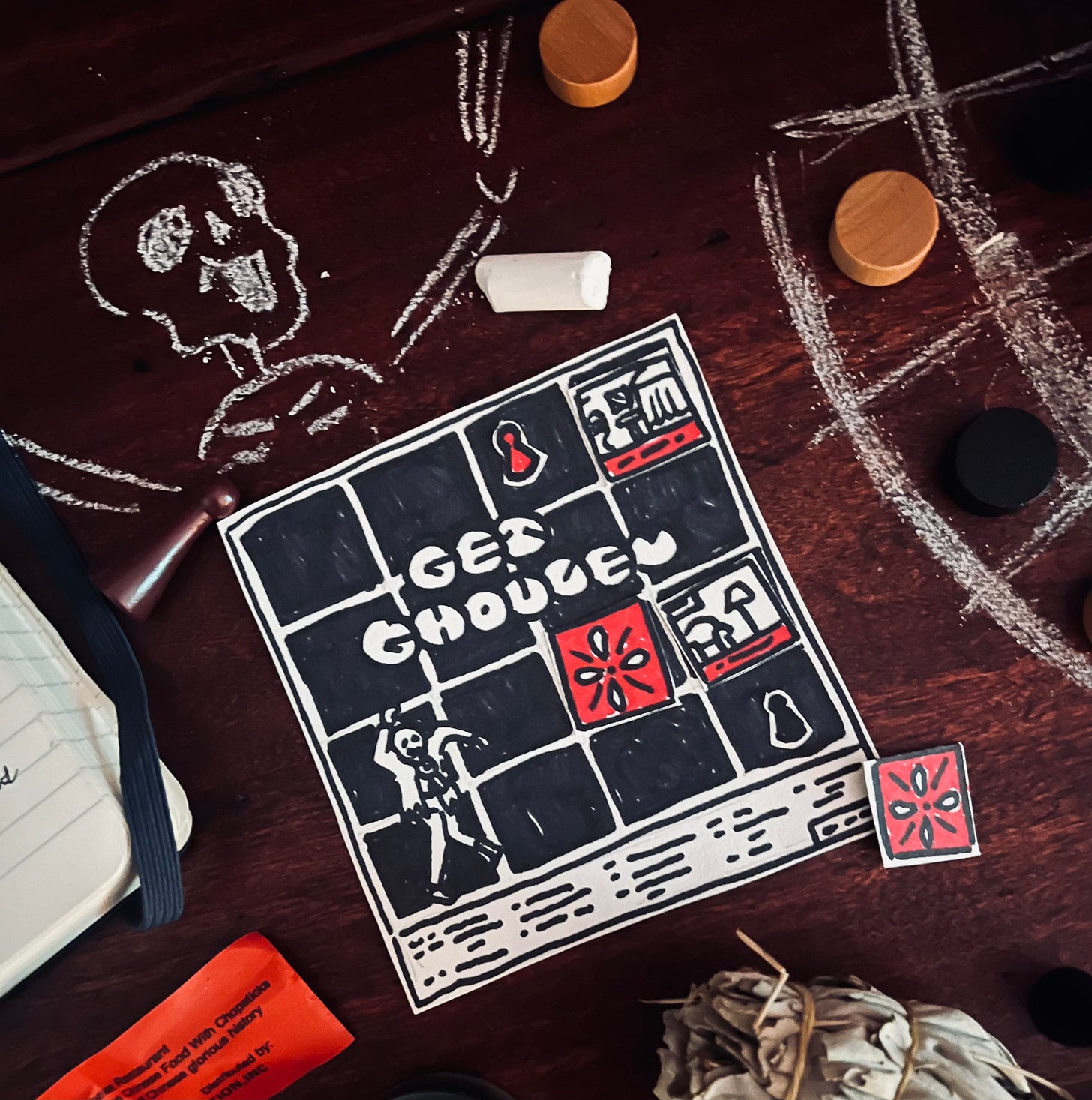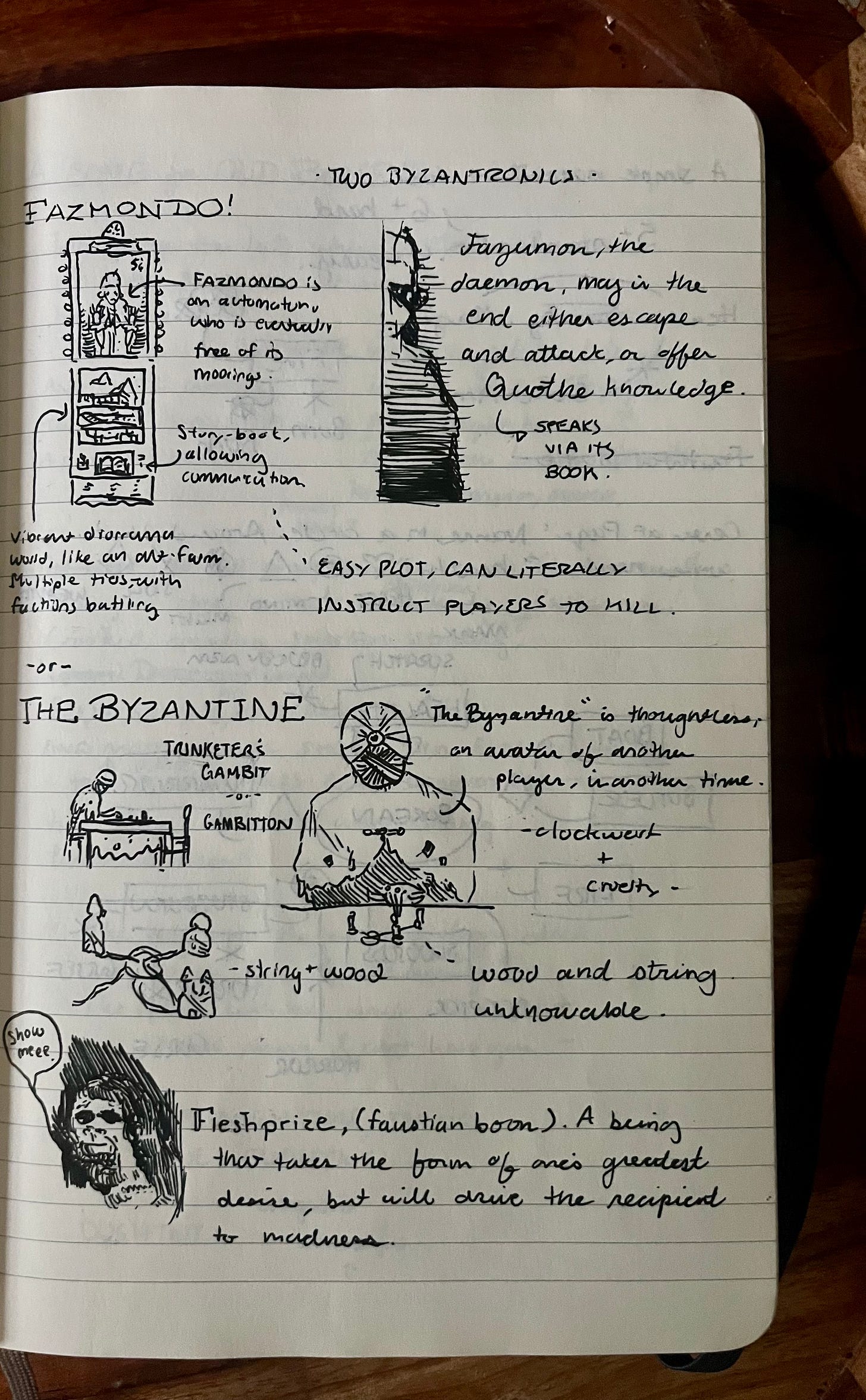IT’S TIME TO GET GHOULEY! UNLESS GHOULEY GETS YOU! RUN AROUND YOUR HOUSE AND GET GHOULEY TOO!
Coincidentally the jingle played on the television as Jamie hid under the bed. Mandy must have turned it on in the living room to scare him. Either way, it was his turn, now.
He took a deep breath. “Get Ghouley, get Ghouley! Did you die by drowning?”
One knock. That means no…
“Mandy! You said you weren’t gonna do that!”
A second knock. That means yes…
“Jamie, shh,” Mandy whispered beside him. Evidently she’d already chosen this as a hiding place. “This spot’s taken!”
A third knock. Maybe the Ghouley died by drowning…
Jamie was trembling. “Who’s that downstairs?”
A fourth knock. It’s getting angry… someone broke the rules.
“It’s the GHOULEY! Now scram and find your own hiding spot!” Mandy pinched Jamie, hard. He would make a break for the shower, and draw the curtain back.
A fifth knock. Time to run.
Jamie hears something run up the stairs, limp down the hall. He just made it into the bathroom in time, holding his breath. Drawing the curtain would make too much sound. All he could do was hold his breath and lay flat…
Stick around to learn all about the family classic, Get Ghouley!
GLIMSVALE GAZETTE
I struggle in moments like these to drop the pretense and write in my own voice. Chronicling for the newsletter brings the same challenge I face in speech-- there’s just too much to say. I wish I could talk the way I can write, with footnotes. A fourth dimension to speech, packaged lumps of enthusiasm or anecdote that slowly dissolve into my sentences like salt in pasta water. That would be nice.
Anyways, The Longest Game is now free. I want you to read it, is why. “Volume I, Side A” (now titled “Boardwalk Rhapsody”) will stay free to access until a few weeks after it’s finished, where it will retire behind the membership paywall.
There’s also a brand-new Table of Contents so that folks can easily navigate the story, and prior entries have all been updated with links. The world of the Longest Game has become a little more readable.
For now, please enjoy. Please let yourself be amused, confused, please just feel things. Please read the footnotes.1
— Benjamin Bagenski
Project Updates
Petracynth capasta!2
GET GHOULEY
… Jamie dared a shallow breath, timed with the wet slap of a rotting foot against the bathroom floor. From the bottom of the bath tub, all he could see was the edge of the sink mirror. Something reflected, blocking the light of the hallway. Wispy hair on an uneven scalp. No rise, no fall. No breathing.
“Coast is clear, Jamie!” called Mandy from under the bed.
The mirror was empty. Jamie heard something took three big, angry steps toward the bedroom where Mandy hid, and the television jingle seemed to fill the house: IT’S TIME TO GET GHOULEY! UNLESS GHOULEY GETS YOU! RUN AROUND YOUR HOUSE AND GET GHOULEY TOO!
Get Ghouley. est. 1972, Salemon Ring Games, Ltd.
— Calumn Quothe, Antique Game Restoration & Research Specialist
Current contents:
water-damaged board, some instruction and “answers” legible
four cardboard “room” squares, bent with peeling paper
two pawns, one red, one black
I’ve been working hard reconstructing Get Ghouley, specifically the 1970s version. The board is a 4x4 grid, and the original game comes with a series of chunky cardboard squares with images of typical household rooms. From what I can tell, players create their “deck" using only cards that matched the layout of their playspace. If your house had one bathroom, for example, you would remove the additional bathroom cards. A house with seven rooms and a hall, therefore, would feature eight cards.
Players shuffle the cards face-down, building a “dungeon” that they explore room by room with their color token. A bone-white wooden pawn, the “Ghouley,” sits on an blank square. The only other component to the came is the text at the bottom of the board— a series of “answers,” matched to numbers. This creates a ouija-like effect.
In theory, players are supposed to “summon” the Ghouley by filling a bowl on the table with “sump’n awful,” though this seems to be a family-friendly version of calling for “some offal.” Players take turns exploring the board, placing their pawns in various rooms and physically going to the space to hide. One player at a time was to physically walk to the board, move their token, and move to the new hiding place before shouting to the Ghouley. They could ask the Ghouley questions if it seemed active, and could banish it by guessing the means by which it died— too many wrong guesses, however, and it would allegedly hunt for players.
You’ll note one major flaw in the game. There’s no way for the Ghouley to actually enter play, rendering the gimmick useless. It assumes the token will move on its own, the spirits knock on their own accord. I imagine, much like players pushing a planchette during a Ouija session (“I’m totally not moving it!”), the game isolates the players from one another so that, unsupervised, they can move the Ghouley token or knock on walls freely to spook one another. Unless, of course, you believe that a board game could summon something evil.
In my research, I believe the game is missing pieces. Some sort of play clock seems implied on certain illustrations. I imaging this is how long after moving your pawn you have to hide or call a question. Possibly it times how long one hides from the Ghouley. There is also no clear ending to the game— maybe there is an “Exit” tile that players are searching for?
I’ll keep this file open, assuming I can find more pieces.
Concept Artwork
Jeremiah Saltpeter was furious at his brother. He’d been betrayed, wronged, crossed-over six times sideways by Hadrian. He sat in his swimming trunks, sitting on the counter as he soaked his feet in the kitchen sink. No tropical getaway, but it would have to do.
“Find me at the shore,” it said. He lit a match, blazing his favorite work— his original artwork of Prince Theodore. Hopefully, dishwater could stand in for seawater.
Jeremiah’s eyes rolled back, and he dreamed of his next creation.
“TWO BYZANTRONICS”: Two mechanical beings are included, above. The second should seem familiar, though Fazmondo! has made a brief appearance in the footnotes found in the Lost Arcade. Back in our Prologue, I found it important that our first footnotes (our first visiting spirits, the ludospex) are summoned when the living brush against the mechanical dead, the readers coated in information like a cloud of dust.
Fazmondo! is an arcade game which houses the daemon Fazumon, a courtier of the Outer Circles. Civilized, and a stickler for rules. Fazumon loves a good dare and a great yarn— his game, a pinball-like Plaything, features magnetic miniatures set within a diorama of a castle and forest. A thick tome turns pages on magnetic strips, providing players with an immersive story, as well as commands. Behind glass, Fazumon watches and waits for a winner who can set him free.
Fazmondo(!) was later replaced by the Byzantine for a first story. The Trinketer’s Gambit game is much more abstract, and I found it a better avenue to introduce readers to the daemons and their Playthings— Fazumon’s game cannot be discussed without delving into the fantasy world of the game-creator, Jeremiah Saltpeter. Better we open with something as simple as warlock’s chess.
The Faustian Boon, a/k/a the Fleshprize, is a different sort of being than the gaming daemons or the ever-present ludospex. Warlocks after all command much power. Their gameplay allow them to manipulate others, alter the environment, and renter spirits material. Perhaps our warlock, Ed Brewster, will give a daemonstration.
Notes from the Damned
IXODIDACTIC CURSES are a wicked thing, the inverse of making a wish while blowing a loose eyelash off one’s finger. They are initiated first by chance— finding a tick wandering on one’s person, yet to latch.3 Put it on the finger and hold in front of you. Think of someone you loathe, and imagine a wicked twist. The method works should the misfortune not be too grand in scale (eyelash wishes often fail for the same reason). Beware: should the tick hold fast to one’s finger when blown upon, then the curse will turn back on the caster.
Arthur E. Smith, “Nature Through The Microscope and Camera” (1909)
The real stories all seeped down here. You can binge them at the end of the chapter, or on Substack you can click on the number and summon the text.
THE FATHER HURTS TO BE AVENGED!
“Paterachavie halcyenthe capaste” in the native Carcossan or, “Petracynth capasta!” in the Autuan brogue.
A condra-andomitante* of a famous play, Liacuste.** In the play, a father takes great pains to avoids the consequences of his actions. This condra is said as a wry acknowledgement one begs for the consequences of their actions.
* A condra-andomitante is an interpretation of an artistic work which intentionally satirizes the meaning of the play to the opposite the author intended. These condras were published much like poems and the best are lauded as literary classics.
** The titular Liacus notably escapes the consequences of his sins in the fifth act of Liacuste by selling his worldly gains and offering it as a boon to the Prince Teostrio at the beach. He then turns into sea foam, fleeing the grasp of vengeance. Liacuste was written by the conservative playwright Ord as an entreaty of fidelity to the Faces of God, and the ending panned by common folk as unsatisfying. When the satirist Herrod Dario published a contra of Liacuste under the pen name “Dro,” he offered an interpretation that Liacus was begging for punishment but his privilege alone kept him safe from harm, and furthermore that turning to sea foam is a lousy fate to be envied only by those out of touch. As the most famous condra-andomitante, it effectively re-contextualized all future performances of the play, popularized it far beyond initial reception, and gave rise to the Old Country’s understanding of karma:
Petracynth capasta!
The trick to any chance-based magic is being a savvy gambler. You cannot keep a pouch of live ticks on your belt to cast curses on a whim, but you take your dog for a walk in an uncut meadow alongside the highway.







